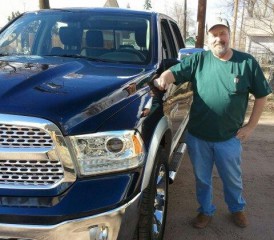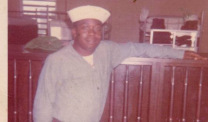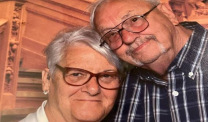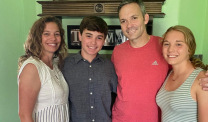Survivor, Navy Veteran Adapts Slowly to Lifestyle Changes
VeteranWritten by Tim Povtak | Edited By Walter Pacheco

Eight months after he was diagnosed with malignant pleural mesothelioma, Nick P. walked into his local Dodge dealership in Colorado Springs, kicked a few tires, and drove away with a shiny new 2013 Ram Heavy Duty truck.
He will drive it almost 800 miles next month to the Phoenix International Raceway, where he will meet his brothers and watch the Advocare 500 NASCAR Sprint Cup Series Race on Sunday before Veterans Day.
He is not sitting home feeling sorry for himself. Far from it.
He’ll be standing and cheering, hooting and hollering, against his least favorite race car driver.
“I like anyone who beats the No. 18 [Kyle Busch],” Nick told Asbestos.com from his home in Colorado Springs. “I’m looking forward to it.” His last name is being withheld over privacy concerns.
Nick, 62, is a combat-tested, U.S. Navy veteran, longtime NASCAR fan and a strong-willed, do-it-yourselfer who is slowly adapting to life as a mesothelioma survivor. He was first diagnosed in July 2012.
“My life is kind of in neutral right now,” he said. “I’m not sure what my next step is going to be, but I’m not going to sit around saying `woe is me. Why did I get this cancer?’ The fact is, it’s there. And there’s nothing I can do to change that, so I won’t sit around crying about it. I’m making plans.”
Making Future Plans
After the race in Phoenix, he has promised his wife a week at a nice waterfront resort in San Diego, where he hasn’t been since leaving the Navy almost 40 years ago. He also is making tentative plans for a spring cruise to Alaska.
He recently finished his latest round of chemotherapy, and his last PET scan showed very slight tumor growth. He is still contemplating his next move, the possibility of finding a mesothelioma specialty center to make sure he is getting the treatment he needs.
He shared some of his concerns, and his possible options, during a mesothelioma support group session hosted by Asbestos.com in October. The sessions are held each month, but this was the first one for him. He found it almost invigorating, offering some tips for others in the group.
“It was good for me, talking with others who have this disease. I know there were days (at first, after the diagnosis) when I didn’t do anything, and then went to bed feeling terrible. I could very easily just sit in my chair, staring at the TV and never move until I get up for another cup of coffee,” he said. “But I realized, you have to get past that, push yourself and go live your life. It makes you feel so much better.”
Frustrated by the Slowdown
Nick found it especially frustrating to slow down physically as a concession to the disease. This is a guy who renovated and expanded his own home, turning it from a 1,000-square-foot dwelling to 2,000 square feet, doing much of the carpentry, electrical, and plumbing work himself.
He also spent 30 years in the maintenance department at a local hospital, the last eight years as the supervisor, learning how to fix almost anything. He repaired his own automobiles at home, doing all the handyman work for him and his neighbors.
It pained him recently to pay someone else to help with repairs in his garage, then pay another person to rebuild the sprinkler system and landscape his front yard, chores he would have much rather done himself.
He was a jack-of-all-trades in the Navy, too. He called them “my four years of college” when he served as a boiler technician, working mostly below deck on a pair of ships during the Vietnam War. It was there where he likely was first exposed to asbestos that eventually led to his mesothelioma diagnosis.
He bravely served his country on the USS Everett F. Larson destroyer and the USS Kiska ammunition hauler. His crew was part of the Haiphong Harbor mining operation that forced North Vietnam to the bargaining table with South Vietnam.
Proud of His Navy Service
He still wears his Navy pin proudly, on the ball cap he will be wearing in Phoenix during the Veterans Day weekend. He looks back proudly on his service in the Navy.
“We never knew how bad the asbestos was for you. It was such a great insulator, a great product for the Navy to use,” he said. “My time in the Navy was a good time. It taught me a lot.”
Although he was given the typical diagnosis with a 6 to 18-month life expectancy with mesothelioma, Nick believes he will exceed that prediction easily. His diagnosis was made earlier than most because of an unrelated lung problem that eventually led to the shocking diagnosis. His wife, Terry, a former ICU nurse who has guided him considerably through the process, is helping him understand what doctors and nurses are trying to accomplish.
“When you’re dealt this kind of diagnosis, you really don’t know where to turn, what to do. She has been a huge help to me,” he said. “I’ve learned more than I ever wanted to know about asbestos, about mesothelioma, about the whole cancer world.”
His younger sister, who introduced him to his wife more than 35 years ago, was diagnosed with brain cancer just two months after he was diagnosed. They have leaned on each other, too, helping one another through the process.
“We talk about who is going to outdo the other, who is going to outlive the other,” he said. “She joked that I just didn’t want to be the only one in the family with a problem, so she joined me.”
Nick can’t move like he once did, but that doesn’t stop him from trying. He has made allowances, but he has far from given up. He’s outside washing the truck. And he sees nothing unusual about his plan to go racing in Phoenix, something he hasn’t done in many years.
“I had someone say ‘I can’t believe you just went out and bought a nice new truck like that. Why would you do that now [with this disease]?'” he laughed. “I told them, ‘because I wanted to.’ I bought a new coffee maker, too. That’s just the way I am. I’m not giving up yet.”






